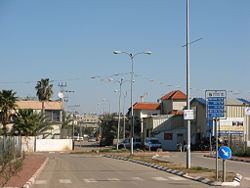Area 190 ha | Local time Saturday 7:04 PM | |
 | ||
Weather 17°C, Wind NW at 14 km/h, 69% Humidity | ||
Jaljulia (Arabic: جلجولية, Hebrew: גַ'לְג'וּלְיָה), officially also spelled Jaljulye, is an Israeli-Arab town in Israel near Kfar Saba. In 2015 it had a population of 9,361.
Contents
Map of Jaljulia, Israel
History
In Roman times the village was known as Galgulis, in while during the Crusader period it was referred to as Jorgilia in 1241 C.E.
In 1265 C.E. (663 H) it is known that the Sultan Baybars allocated equal shares of the village to three of his amirs. One of these, amir Badr al-Din Baktash al-Fakri, included his section of the village in a waqf he established. Excavations of a building close to the Mamluk khan yielded ceramics dating to from that period.
Ottoman era
In 1517, the village was included in the Ottoman Empire with the rest of Palestine, and in the 1596 tax-records it appeared located in the nahiya (subdistrict) of Banu Sa´b under the Liwa of Nablus, with a population of 100 households ("Khana"). It paid taxes on a number of crops, including wheat and barley, as well as "summer crops", "occasional revenues", "goats and bees", and a market toll. There was also a poll tax, jizya, paid by all the inhabitants in Sanjak of Nablus. All the inhabitants were Muslim.
Jaljulia appeared under the name of Gelgeli on Jacotin's map drawn-up during Napoleon's invasion in 1799.
In 1870, Victor Guérin found that the at the village had six hundred inhabitants. In 1882, the Palestine Exploration Fund's Survey of Western Palestine described it as being a large adobe village on the plain. The mosque was described as fine, but ruined. A ruined Khan was also mentioned. Water was supplied by a well on the west side of the village.
During the Sinai and Palestine Campaign of World War I, the village was on the Ottoman front line and was damaged by British artillery.
British Mandate era
In the 1922 census of Palestine conducted by the British Mandate authorities, Jaljulieh had a population of 123, all Muslims, increasing in the 1931 census to 260, still all Muslim, in a total of 60 houses.
By 1945, the village had 740 inhabitants, all Muslims. They owned a total of 11,873 dunams of land, while 447 dunams were public. Jews owned 365 dunams of land. A total of 2,708 dunams were for citrus and bananas, 175 dunams for plantations and irrigable land, 9,301 for cereals, while 15 dunams were built-up (urban) land.
After the 1948 war, Jaljulia was on the Arab side of the ceasefire line and its land was confiscated by Israel. It was transferred to Israel in the 1951 armistice agreement but failed to recover its land, which had been given to new Israeli settlements.
Landmarks
The mosque is locally known as Jami Abu´l-Awn, which associates it with the 15th-century religious leader Shams al-Din Abu´l-Awn Muhammad al-Ghazzi, who is known to have come from the town. The architecture of the mosque is, according to Petersen, consistent with a 15th or early 16th century construction date.
At present the structure consists of one large vaulted chamber, and three small barrel-vaulted cells. A large second chamber to the west was destroyed by British artillery during World War I.
The Khan is located opposite side of the road of the mosque.
The Khan was built by Sayf al-Din Tankiz, the governor of Damascus 1312–1340, and it was still functioning in the 16th century, when it was mentioned in an Ottoman firman. In the 19th century it was seen by Guérin, who described it as a beautiful khan with a (ruined) polygonal minaret.
Petersen, who surveyed the structure in 1996, found the courtyard entirely overgrown and it was not possible to detect any features within, however, he notes that a 19th-century visitor had mentioned that there was "a great round well" in the centre.
Sports
In 2010, a tennis school was established in Jaljulia by Iman Jabber and Daniel Kessel. In 2011, 50 girls and 20 boys signed up for tennis lessons. The school organizes coexistence matches between Jaljulia and Ra'anana.
